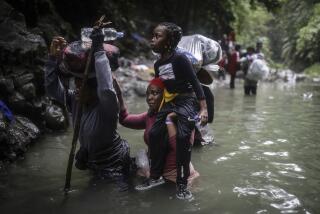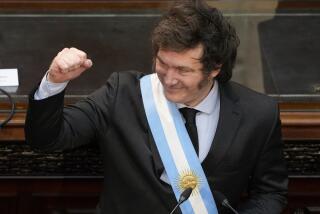Anti-coca spraying halted in Colombia after 2 U.S. pilots shot down
BOGOTA, Colombia — U.S.-funded anti-coca spraying in Colombia has been suspended indefinitely in the aftermath of the shooting down, apparently by leftist rebels, of two spray planes and the death of one of the American pilots, sources confirmed Monday.
One fumigation airplane was shot down Sept. 27, killing the pilot, whose name was not made public. A second crop-duster was brought down Oct. 5, prompting the U.S. Embassy in Bogota to suspend spraying, according to one well-informed source who spoke on condition of anonymity because he was not authorized to talk to the press.
Although the crashes were reported shortly after they occurred, it was not reported until this week that both were brought down by hostile gunfire from the Revolutionary Armed Forces of Colombia, or FARC.
The rebel group’s involvement and suspension of flights were reported Sunday by La Silla Vacia, a respected online newsmagazine based in Bogota. Neither the U.S. State Department nor the U.S. Embassy in Bogota responded Monday to requests for confirmation and further details, including the identity of the dead pilot.
According to the Associated Press, the first shoot-down occurred 250 miles northeast of Bogota near the town of Tarra, killing the pilot. The second incident reportedly occurred in the southern province of Caqueta, where the FARC is still strong and allegedly engaged in cocaine processing and transport to neighboring Ecuador.
At the time the aircraft were downed, the U.S. Embassy said only that it was analyzing the cause of both crashes.
At least six U.S. pilots have been killed in the spraying program since 1995, according to recent interviews with U.S. Embassy staff. Danger comes not just from enemy gunfire but also high-tension wires and palm trees.
The planes are slow but powerful propeller-driven aircraft with 1,385-horsepower engines that are capable of carrying up to 800 pounds of herbicide.
In a 2009 interview, one of the U.S. pilots, a contractor with DynCorp, told The Times that the planes made easy targets for rebels and drug traffickers but that he felt safe from gunfire with the cockpit’s 3/4-inch armor. According to the Associated Press, the embassy is analyzing how gunfire penetrated the shield.
The U.S.-financed fumigation effort has eradicated an estimated 4 million acres of coca, the raw material for cocaine, over the last two decades. The program uses mostly contracted American pilots who spray industrial variants of the weedkiller Roundup from several hundred feet.
Since 2000, the program has been part of Plan Colombia, the anti-drug and anti-terrorism aid program that has funneled more than $8 billion in military, humanitarian and institution-building funds to this Andean nation.
According to recent interviews, the spray portion of the annual Plan Colombia aid allotment costs about $50 million per year. The area sprayed, according to United Nations and U.S. Embassy figures, totaled about 250,000 acres in 2012 and 258,000 acres in 2011. At the peak in 2006, more than 425,000 acres were sprayed.
Kraul is a special correspondent.
More to Read
Start your day right
Sign up for Essential California for news, features and recommendations from the L.A. Times and beyond in your inbox six days a week.
You may occasionally receive promotional content from the Los Angeles Times.






